Antonio Conte’s tactical influence on Napoli has brought a new dimension to their play, blending his well-known principles of organization and intensity with Napoli’s attacking flair. Conte’s emphasis on defensive solidity, disciplined structure, and rapid transitions has reshaped how the team approaches each match. This analysis dives deep into Conte’s tactical approach at Napoli, examining the key formations, player roles, and strategic decisions that define his time at the club. From pressing patterns to attacking movements, we’ll break down how Conte has crafted a competitive and resilient Napoli side.
Defending
Antonio Conte’s Napoli showcases tactical versatility by using different formations when defending, depending on the situation and opposition. Often, Conte employs a compact 1-5-3-2 or 1-5-4-1 setup, focusing on defensive solidity and blocking central spaces. The back five ensures coverage across the width of the pitch, while the midfield stays disciplined, cutting off passing lanes. Against more aggressive opponents, Conte might shift to a 1-4-5-1 formation, maintaining defensive width but adding more pressing elements in midfield. This versatility in their defensive approach allows Napoli to adapt to various opponents, giving them an edge in different match scenarios.
1-5-3-2
In most games, Napoli defend in a 1-5-3-2 formation, looking to set up in a mid to low-block, always closing the center and forcing the opposition out wide.
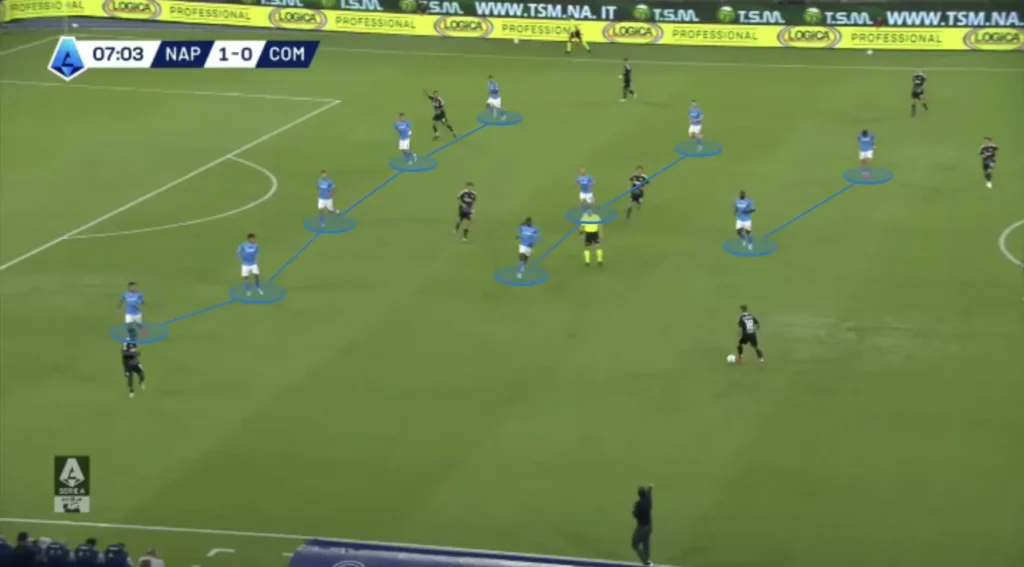
Defending in the 1-5-3-2 formation is centered around maintaining compactness and leveraging the numerical strength in midfield. The three center-backs form a solid defensive base, supported by the wingbacks who drop back to create a five-man defensive line when under pressure. This structure allows the team to cover wide areas effectively, while the central midfielders are responsible for controlling the middle of the pitch and providing additional cover for the defense. The two strikers often play a key role in initiating the press, forcing the opposition to play wide or make risky passes. The defensive midfielder, positioned just in front of the back three, acts as a shield, breaking up play and closing down spaces that the opposition could exploit. This setup provides balance, with the ability to defend deep and counterattack quickly, while also being flexible enough to press higher up the pitch when needed.
In the 1-5-3-2 formation, Napoli are great at stopping the opposition from quickly switching sides. When the ball is on one side, the Napoli players always close the entries to the midfield and force the opposition to switch the play by going all the way back to the center-backs. To do this, the ball-side wingback, ball-side midfielder, and the two strikers form a diagonal line. This diagonal line stops the opposition from going through the middle to switch sides. Instead, they have to go back to the center-backs and, from there, get the ball to the other fullback. This gives Napoli enough time to shift across, allowing them to keep the compact shape.
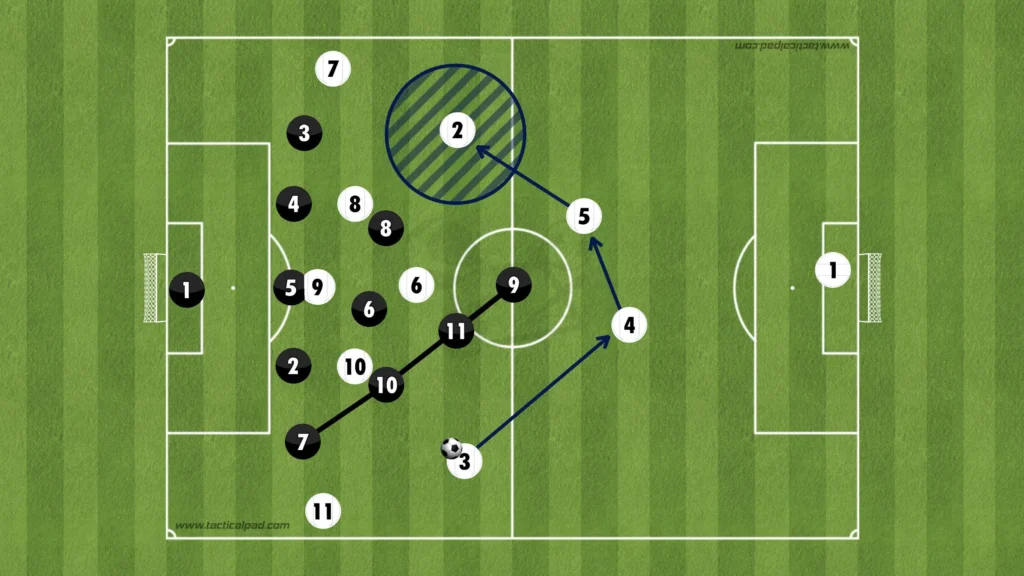
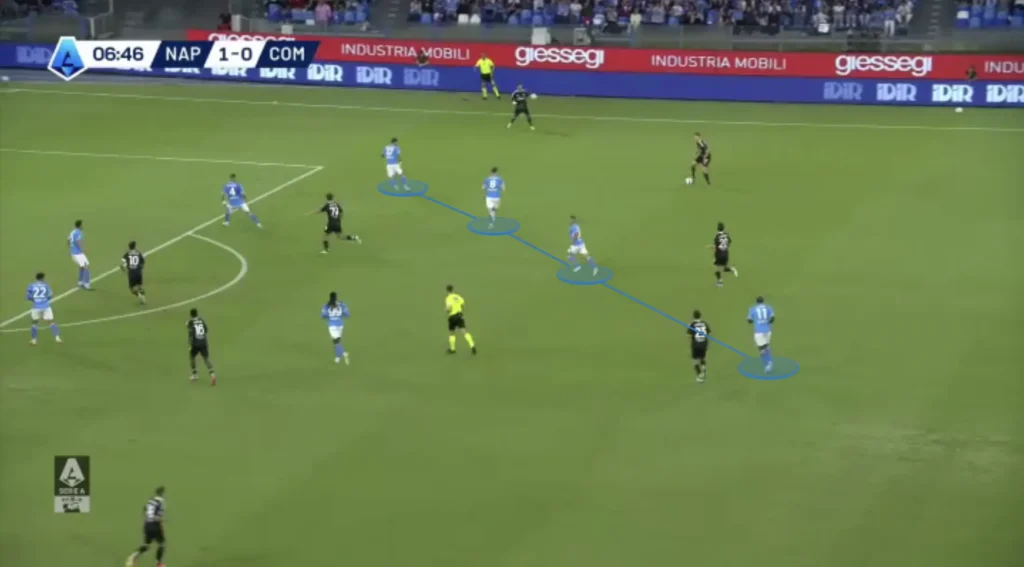
1-5-4-1
In some games, Napoli have used a 1-5-4-1 formation when defending. In the 1-5-4-1 formation, they still look to set up in a compact mid-block, closing the center and stopping the opposition from penetrating through the midfield.
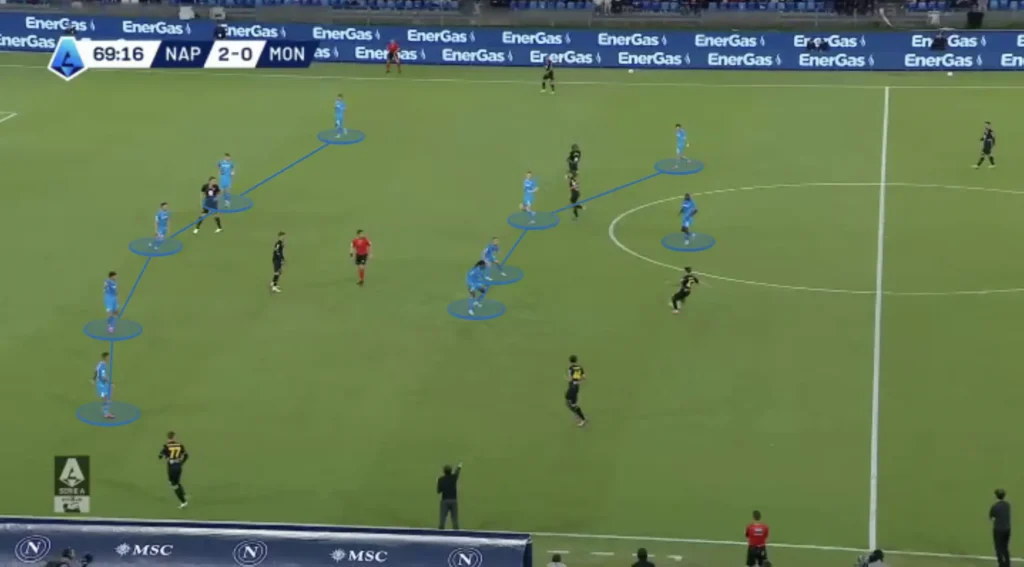
Defending in a 1-5-4-1 formation emphasizes solidity and compactness, making it particularly effective against teams that rely on wide play or quick transitions. The five defenders, including three center-backs and two wing-backs, create a strong defensive line that can absorb pressure and cover the width of the pitch. The four midfielders in front of the backline provide an additional layer of protection, often pressing the ball and cutting off passing lanes, while also helping to maintain the team’s shape. The lone striker remains higher up the field and usually tries to push the opposition to one side. This formation aims to limit the opposition’s space, forcing them to take risks or attempt crosses, which can be more easily defended with the numbers in the box.
1-4-5-1
Napoli have also defended in a 1-4-5-1 formation.
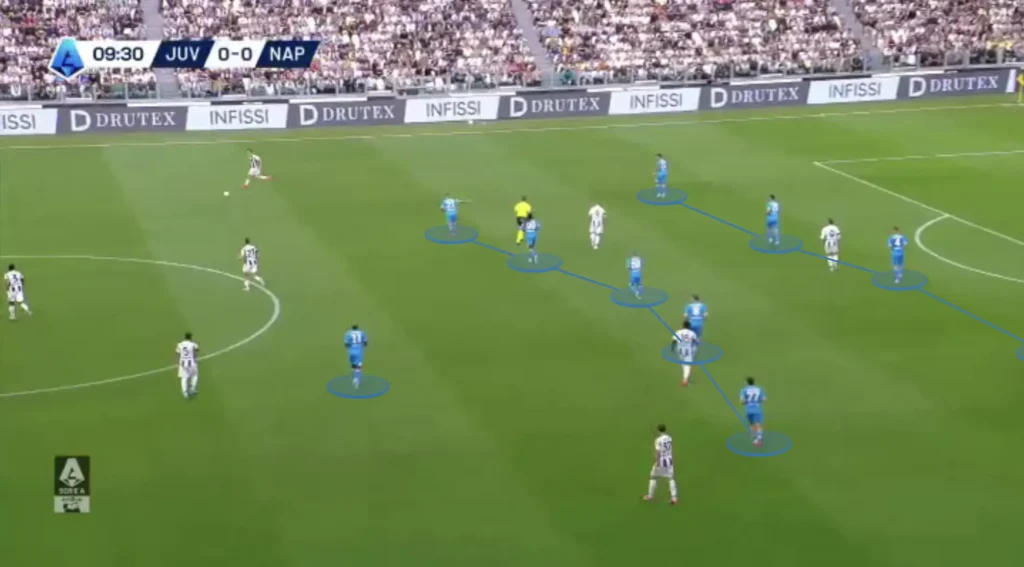
Defending in a 1-4-5-1 formation is also centered around maintaining a compact and organized structure that makes it difficult for the opposition to penetrate through the middle. The back four stays narrow and disciplined to protect the central areas. Meanwhile, the midfield line of five works in unison to press the opposition, forcing them wide where the fullbacks can engage. The lone striker remains high, ready to apply pressure on the ball when it enters the defensive zones.
The opposition backline will have a numerical advantage at the back when Napoli are defending with only one striker. When the striker pushes up to press one of the center-backs, the ball can be played to the other center-back, who can take the ball forward. To stop this center-back from advancing too far, a Napoli central midfielder might have to push up. If a midfielder pushes up, space opens up in the midfield. To stop this from becoming an issue, the other Napoli midfielders must drop back behind the pushing midfielder to stop the opposition from exploiting this space.
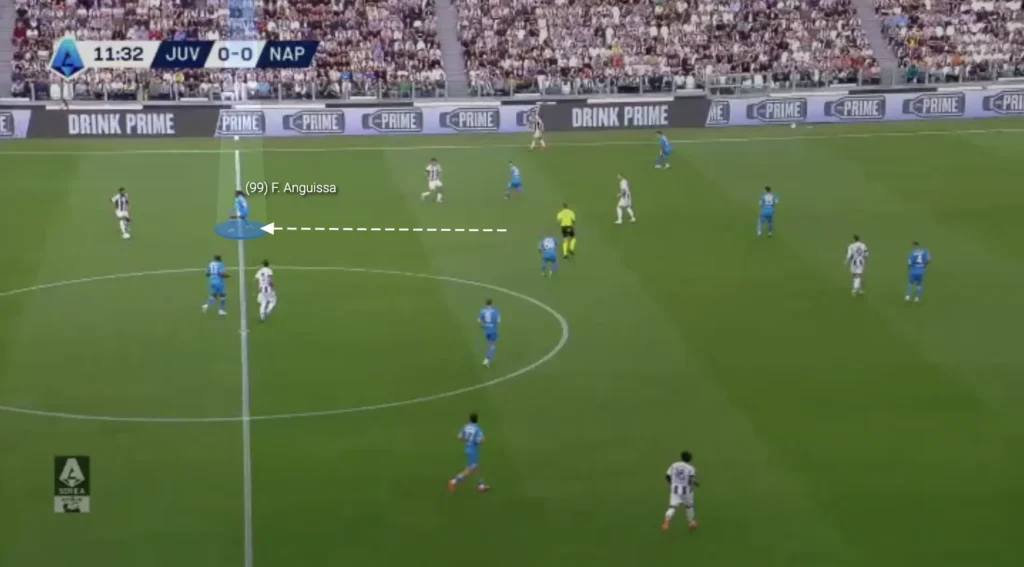
Compactness
Antonio Conte’s Napoli is known for being extremely compact when defending, a hallmark of his tactical philosophy. Regardless of the formation, the team maintains a tight defensive shape, often utilizing a low or mid-block to close down spaces between the lines and limit the opposition’s passing options. Conte ensures his players stay close together, reducing gaps for opponents to exploit and making it difficult for them to progress centrally. The compact structure allows Napoli to defend in numbers, with players quickly collapsing on the ball when it enters their zone, forcing the opposition to play wide or attempt risky passes. This disciplined approach not only frustrates opponents but also enables quick counterattacks when possession is regained.
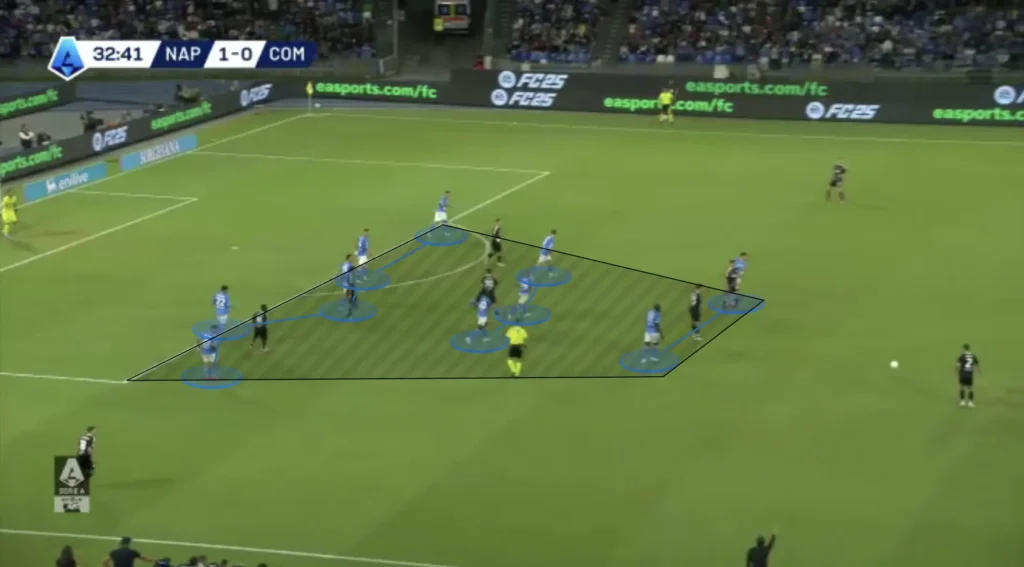
Aggressive Center-backs
A notable aspect of Napoli’s five-at-the-back low defending is their aggressive wide center-backs. The wide center-backs are never afraid to push up on an opposition midfielder to stop them from turning and driving with the ball. This forces the opposition back while giving the Napoli midfielders and attackers more freedom to push up and press when defending. The problem with pushing up a center-back is that big spaces get created between the defenders. Conte’s players are, however, great at solving this. The backline will quickly become a compact back four, with the defenders coming across to close the space that the pushing center-back opened.
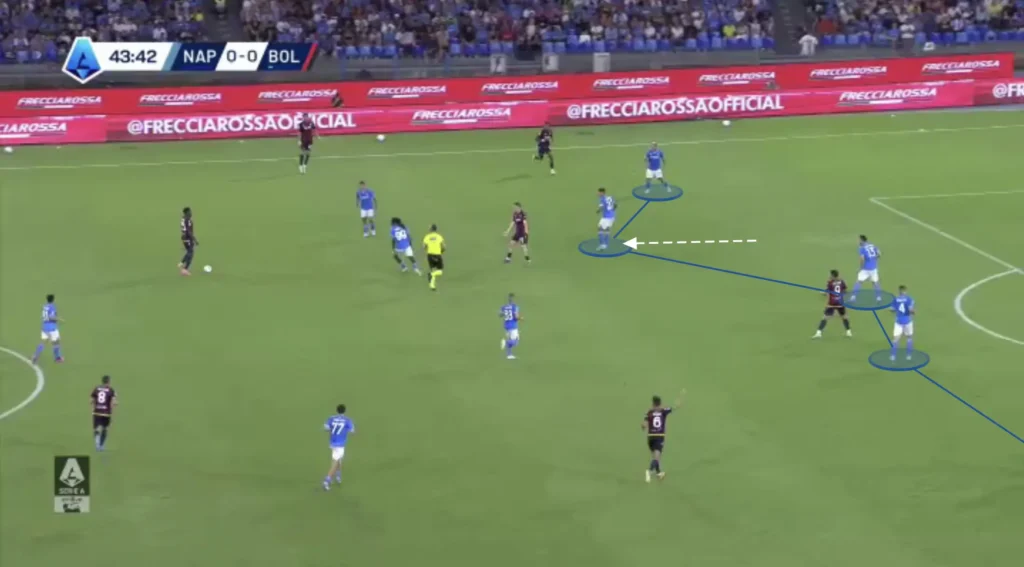
Squeezing the Pitch
Additionally, Conte always wants his team to squeeze the pitch when defending, regardless of the formation. This means constantly pushing the team up as much as possible. Every time the opponent plays a slow, sideways pass or a back pass, Napoli’s first line of pressure pushes up, with the rest of the team following to stay compact. When the next pass comes, they push up even more, forcing the opponent back even more. They do this because it pushes the opponent further away from Napoli’s goal, making it harder to create chances.
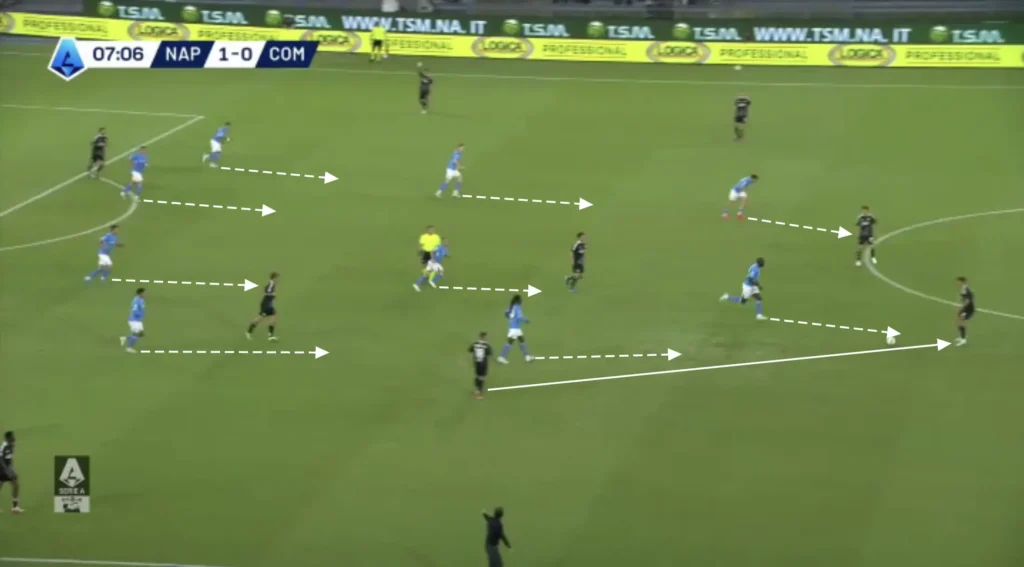

High Press
Conte places much value on being aggressive without the ball. This shows in Napoli’s high pressure. Conte usually wants his team to go man-to-man and intensely press the opposition. Each player is assigned a direct opponent to mark tightly, ensuring no easy passing options are available. This intense pressure forces the opposing team into hurried decisions, often resulting in turnovers in dangerous areas. Napoli almost use their high press as an attacking threat, scoring many goals from winning the ball high up the pitch.
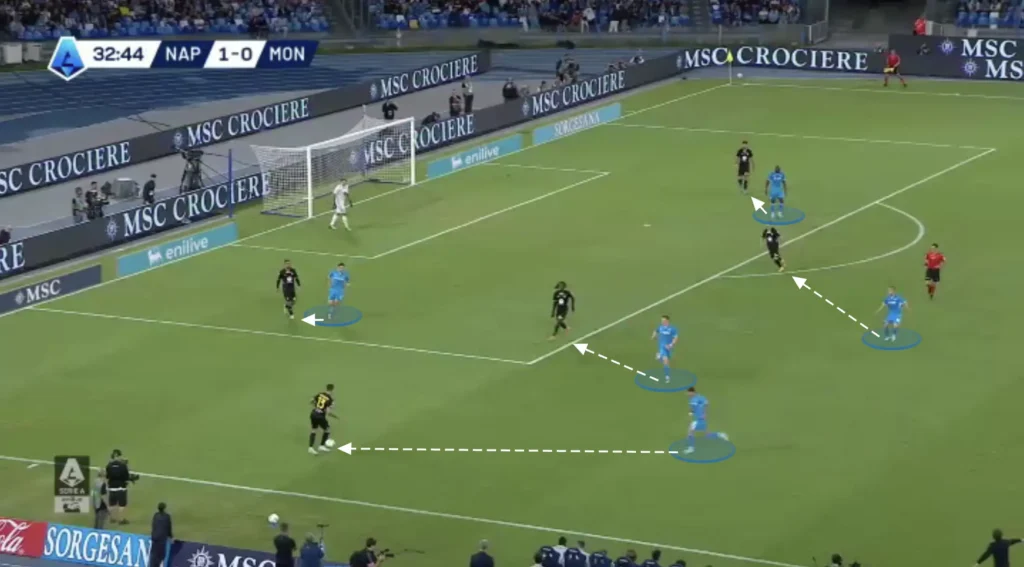
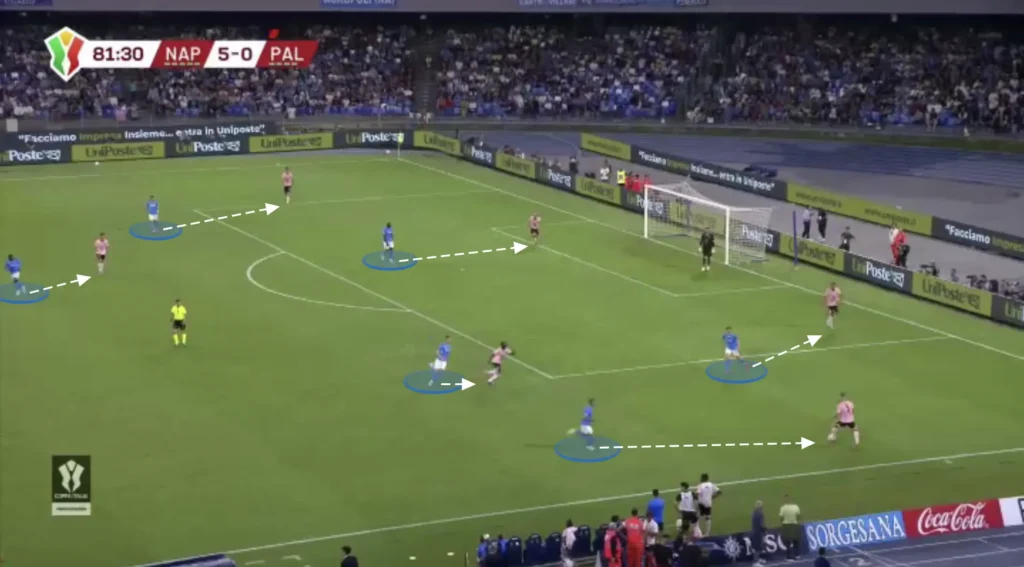
In a man-to-man system, it becomes crucial that the players know when to mark the opponent they are responsible for and when not to. If an opponent, for example, is very far from the ball, the Napoli player marking him does not need to be as close to him. He can instead come in and help create numerical superiorities in the center, decreasing the risk of dangerous 1v1 situations. The Napoli players will always have an opposition player they are responsible for. However, they will never be closer to them than they need to be.
Here, the Napoli midfielders see that the opposition goalkeeper is playing a long ball, making the opposition players close to the goalkeeper irrelevant. Instead of staying with their players, they drop back, which puts them in a better position to win the second-ball.
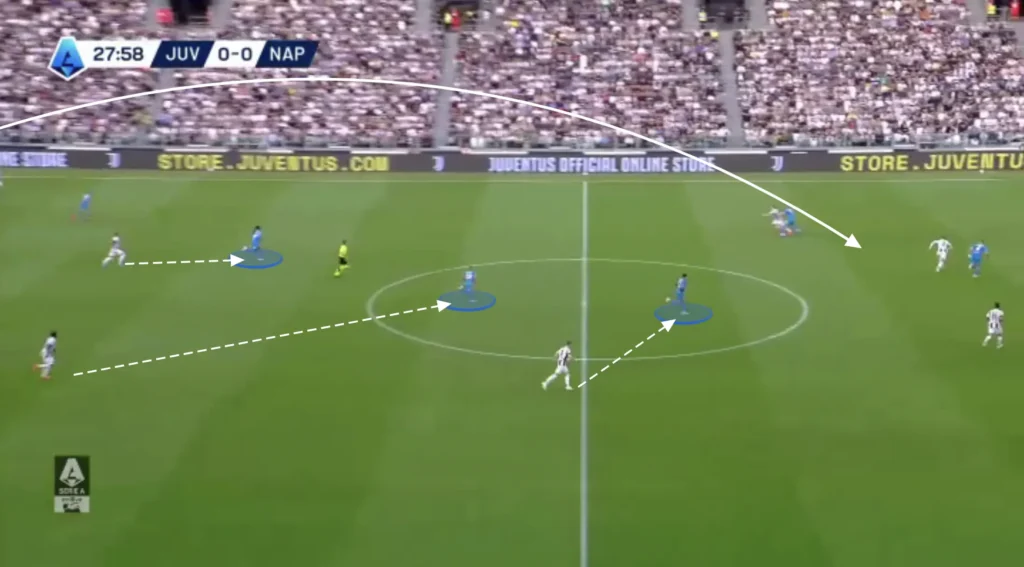
Build-up
Low Build-up
In the low build-up, Conte sets his team up in a 1-4-2-4 formation.
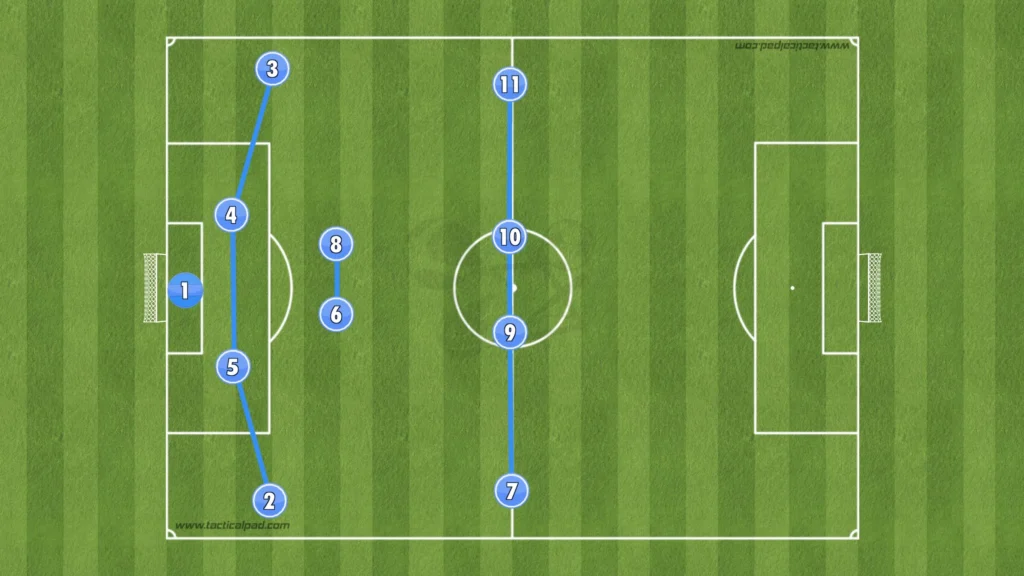
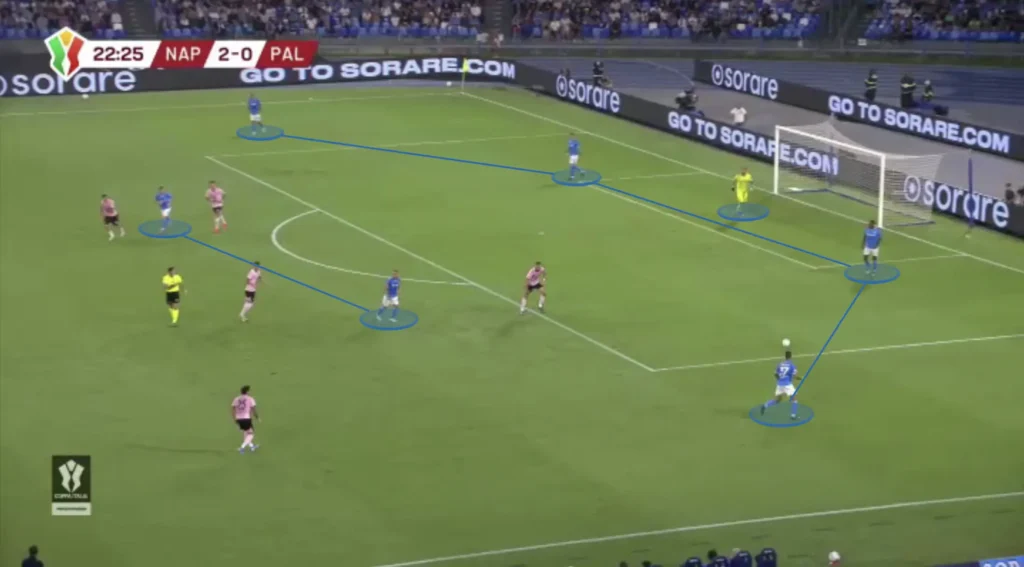
The wingers usually start wide and come in when the play starts. This often gives Napoli a numerical superiority in the midfield, which will help them beat the opposition’s press. The wingers also have better conditions to win the second balls when they are in the middle. When the goalkeeper plays a long ball toward the strikers, they will work together to win the second ball, which allows Napoli to establish possession higher up the pitch.
Additionally, Conte usually starts with Romelu Lukaku and Scott McTominay as the two strikers.
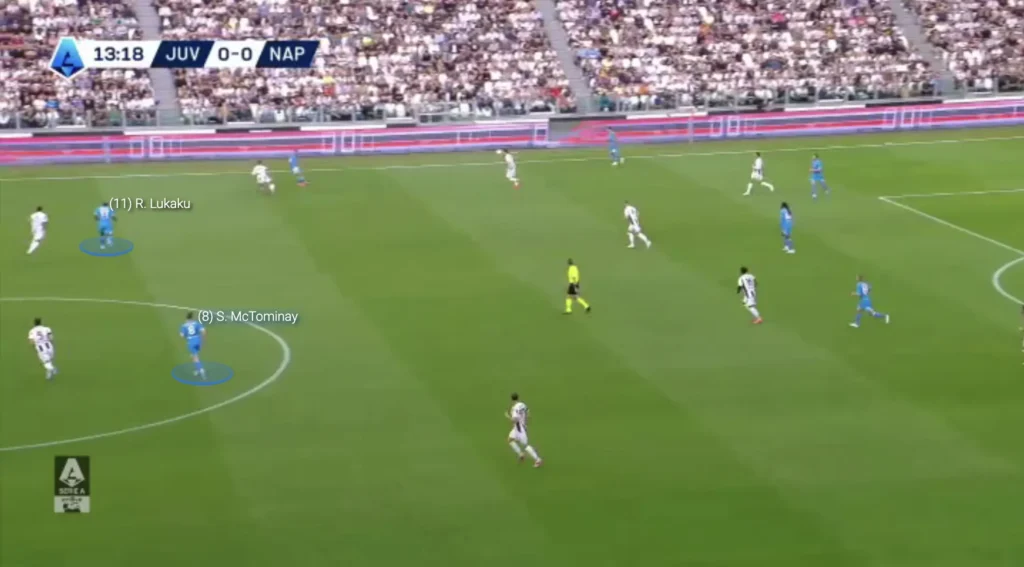
These two excel in hold-up play, using their physicality and technical ability to control the ball under pressure and bring teammates into play. Both players are highly effective at receiving long balls, whether it’s from goal kicks or deep passes, using their strength and balance to shield the ball from defenders. They will often bring down the longer passes and find a teammate in the space between the opposition’s midfield and defense, allowing Napoli to progress the ball forward.
High Build-up
In the high build-up, the Napoli wingers usually move in as attacking midfielders, creating a 1-4-2-2-2 formation
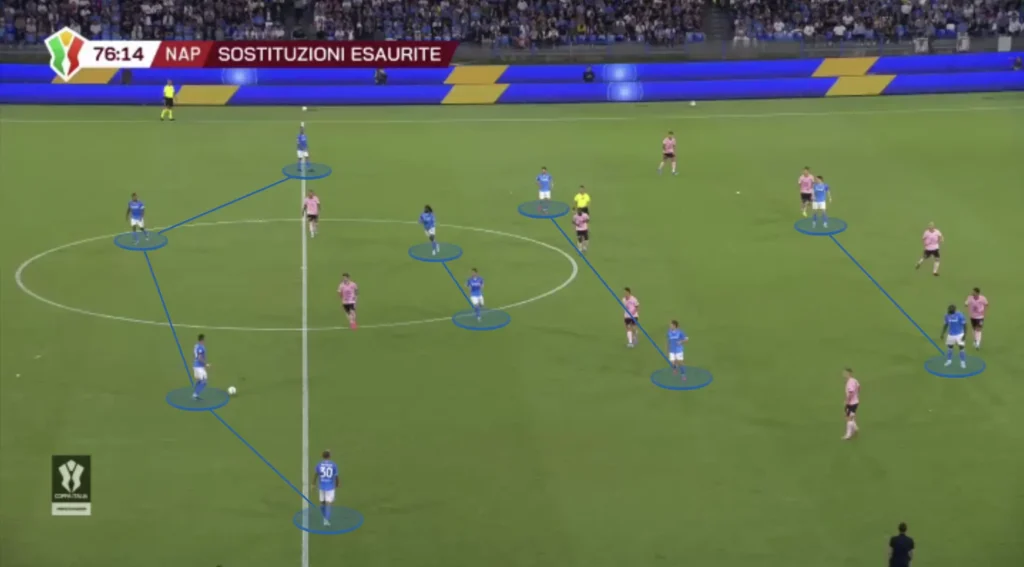
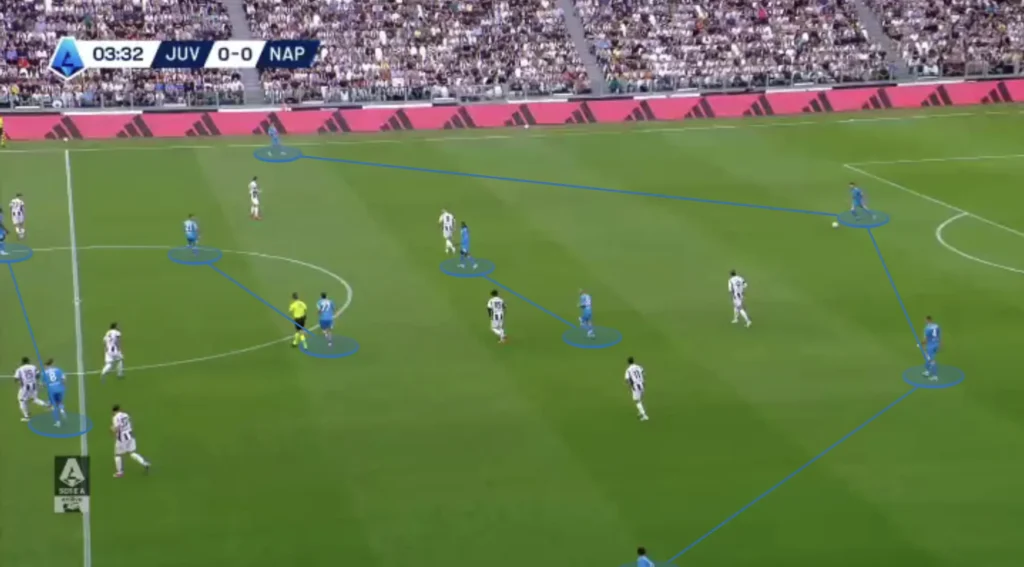
Building up in a 1-4-2-2-2 formation emphasizes direct progression through the center. The back four provides a solid base, while the two defensive midfielders offer stability and options for short passes. These midfielders are key in recycling possession and distributing the ball to the fullbacks or the two advanced midfielders. The 2-2 midfield structure creates opportunities for quick combinations and overloads in the middle of the pitch, which can help bypass the opposition’s press. The two forwards often stay high, stretching the defense and creating space for the midfielders to exploit with through-balls or diagonal passes.
Sometimes, mainly against the worst teams, Napoli will use a 1-3-2-5 in the high build-up.
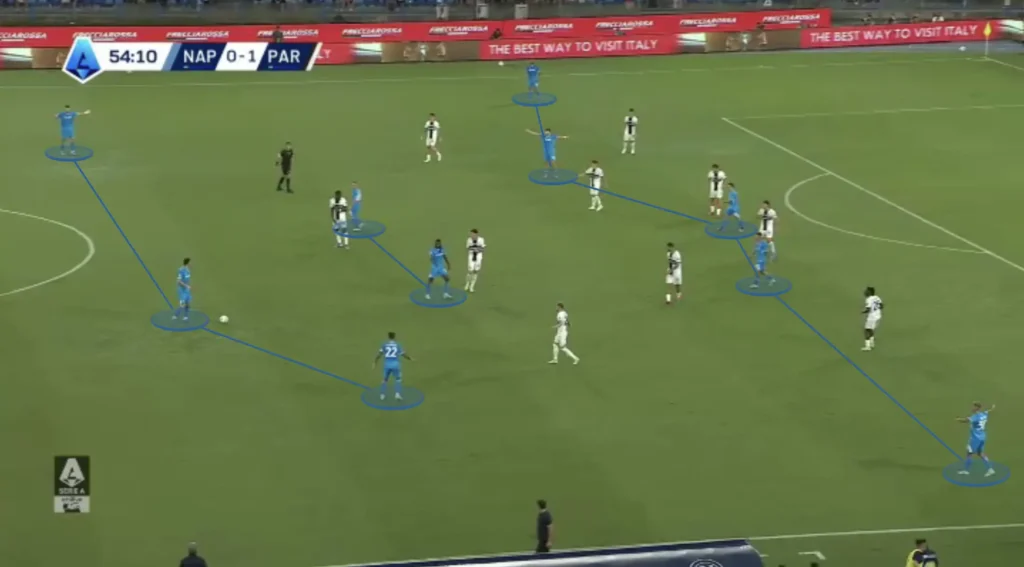
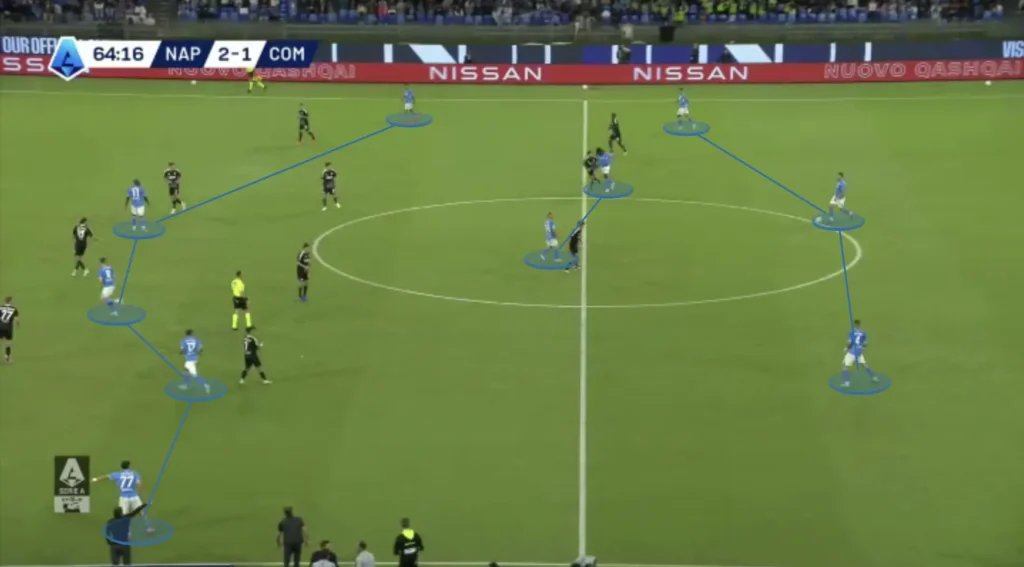
Building up in a 1-3-2-5 formation as opposed to a 1-4-2-2-2 formation focuses on creating numerical superiority in the midfield while maintaining width through the wingers. The three center-backs provide a solid defensive base, with the two wide center-backs stretching the opposition’s press, creating space for the wingers to push up and occupy the flanks. In midfield, the double pivot provides passing options and ensures control in the center, while the attacking midfielders stay high and centrally, ready to exploit any gaps in the opposition’s defense.
Rotations and Fluidity
The Napoli players constantly rotate during the build-up. The team adopts a dynamic approach, shifting between formations to create numerical advantages and exploit spaces. Conte’s focus is always to get the players into their best positions, where they can make the most out of their individual skills. He emphasizes versatility, with players interchanging positions seamlessly to maintain possession and disrupt the opposition’s defensive structure. This flexibility creates numerical superiorities in different areas, allowing Napoli to bypass the opposition’s press while maintaining control.
When playing in the 1-4-2-2-2 formation, Conte will, for example, often drop a holding midfielder down between the center-backs. This shift creates a back three, allowing Napoli to maintain defensive stability while gaining more control in possession.

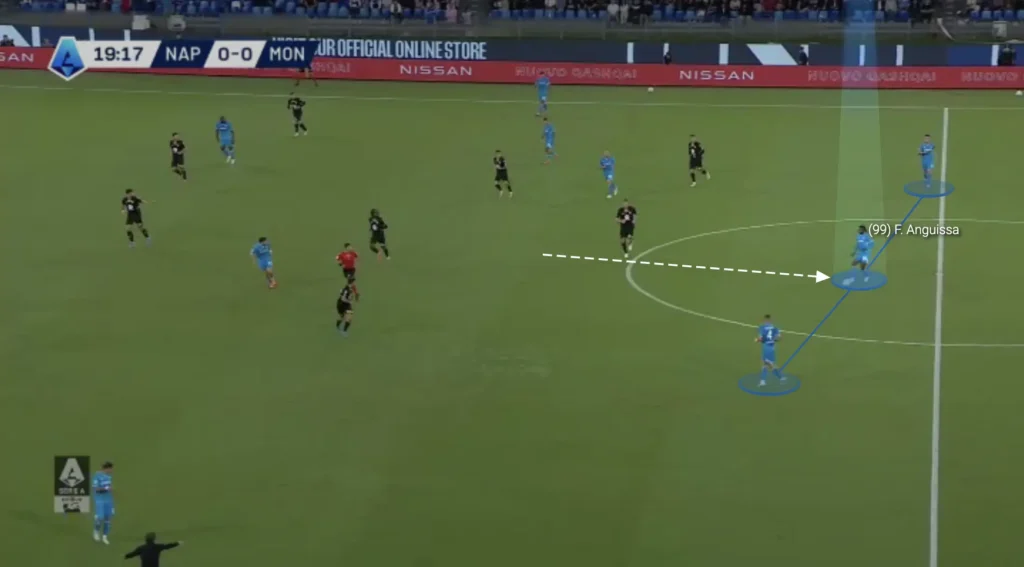
By doing this, Napoli not only widen the field but also open up different angles for passing, making it easier to beat the opposition’s press. This tactical adjustment gives them more options in progressing the ball up the field and disrupts the opponent’s pressing structure, helping them maintain fluidity in their play.
Numerical Superiority in the Midfield
Regardless of the formation, Napoli will have many players in the center. Conte usually has one wide player on each side and positions the remaining eight players in the middle. Having only two players out wide and the rest in the middle creates more options in the center and less space between the players. Conte likes this because he prioritizes playing through the middle. He needs one player out wide to pull the opposition apart while the rest create numerical advantages in the midfield areas.
When a team outnumbers the opposition in the midfield, it can more easily retain the ball, exploit spaces, and progress the ball through the center. Napoli will often progress the ball through quick central passes between the midfielders, beating the opposition’s press and exploiting gaps in the defense. At the same time, having many players centrally builds good conditions in defensive transitions since it allows more players to counterpress when they lose the ball.
Another purpose for keeping many players in the middle is to shorten the distance between them. This shortens the length of the passes, which naturally shortens the time between passes. This means the opposition players will have less time to push up and press, giving the Napoli players more time and control.
High Backline
A massive aspect of Conte’s high build-up is to have the defenders high up. This helps in the counterpress because they get closer to the center. Having more players close to the center who can win the ball back makes it difficult for the opposition to do anything when they win possession. Furthermore, the high backline shortens the distance between players, shortening the time and length of the passes and preventing the opposition from pushing up their defense.
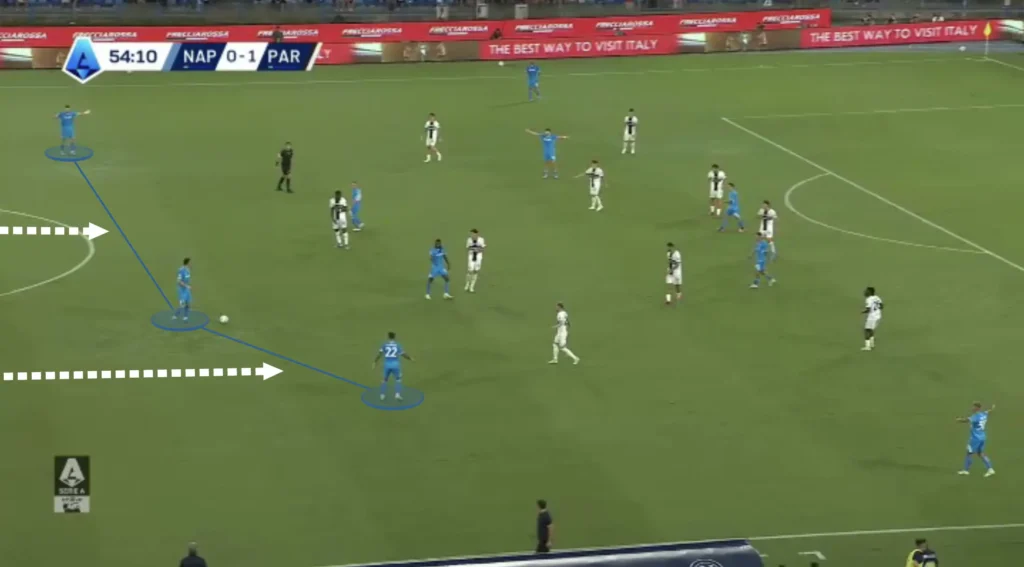
Finding the Pockets
Conte’s players always try to find the attacking midfielders in the pockets. These “pockets” refer to the spaces between the opposition’s defensive and midfield lines, where the attacking midfielders can receive the ball in more advanced positions.
By positioning themselves intelligently in these pockets, the attacking midfielders can turn quickly and face the opposition’s goal, creating opportunities for through balls, driving runs, or direct shots. This positioning forces the opposition to make difficult decisions. If an opposition defender steps up and closes down the attacking midfielder, he potentially leaves space behind. If he stays back, he allows the midfielder time on the ball. The Napoli defenders and holding midfielders will look for straight passes, breaking the opposition lines and finding the attacking midfielders who can turn and drive at the defense.
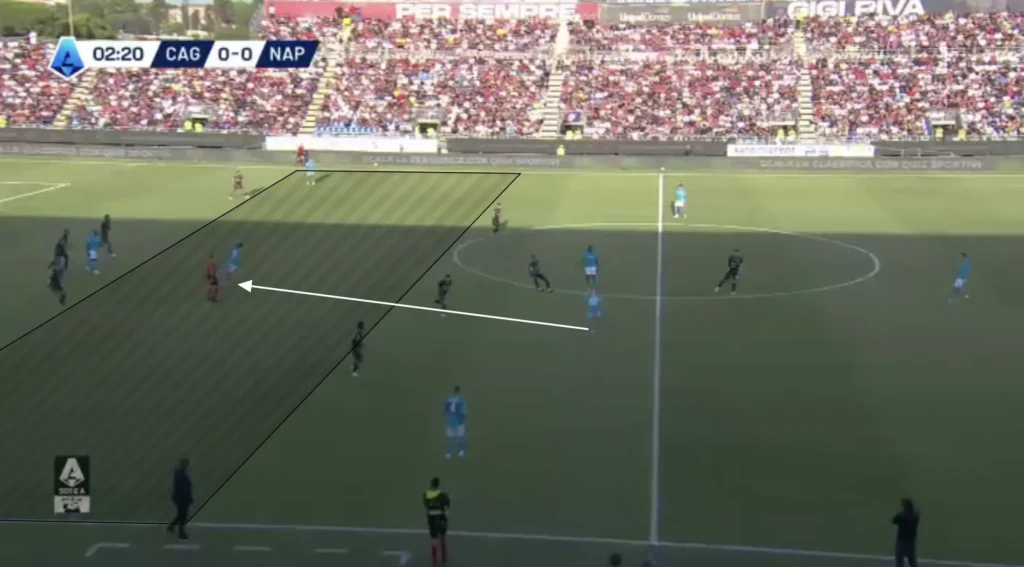
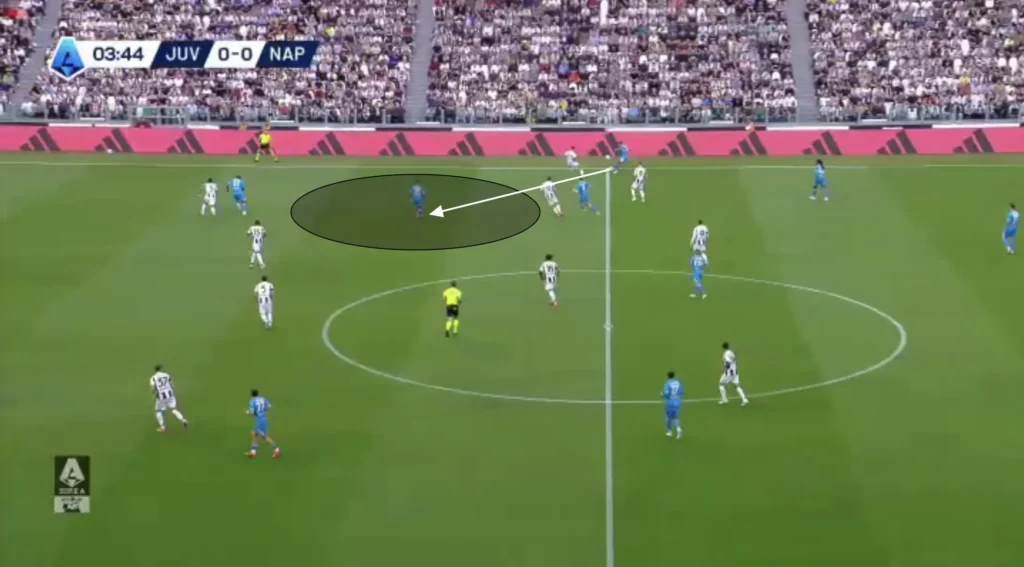
Finding these pockets is crucial for maintaining fluidity in attack and ensuring that the team can progress the ball effectively through the middle of the pitch.
Numerical Advantages Against the Opposition’s Defense
In the 1-3-2-5 formation, Napoli are great at creating numerical advantages against the opposition’s defensive line. Playing with a front five means the forward line naturally becomes numerically superior against a back four.
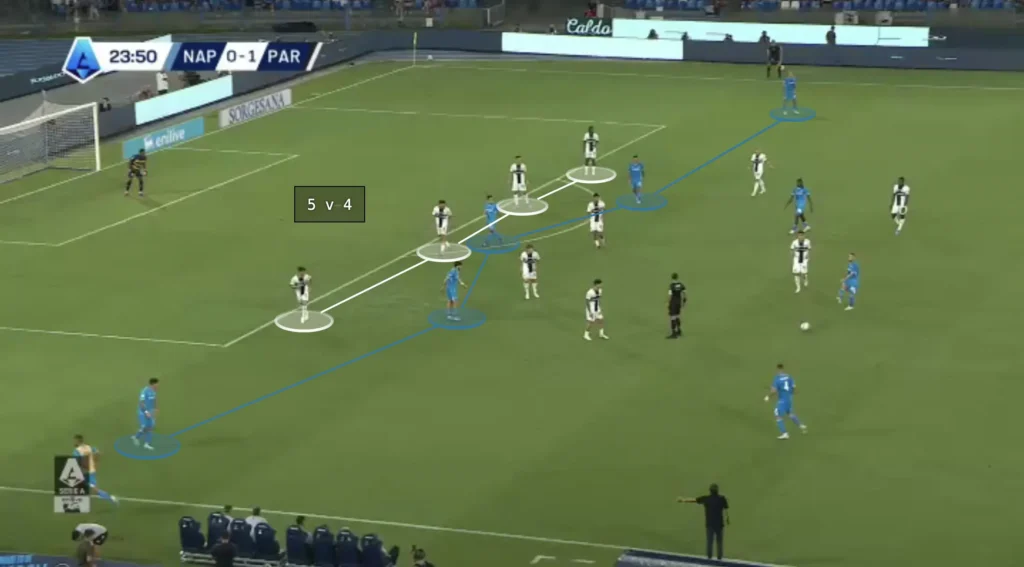
Conte’s players mainly exploit this by creating 2v1 situations against the opposition fullback. When the defending team is positioned on one side, the weak-side fullback becomes vulnerable to the switch of play due to the 1v2 against Napoli’s winger and attacking midfielder. The attacking midfielder will make a run in behind, the fullback will follow that run, and the space for the winger out wide will be opened. Conte’s team often capitalizes on this by getting the ball to the winger and creating many opportunities from 2v1 situations on the wing and in the half-spaces.
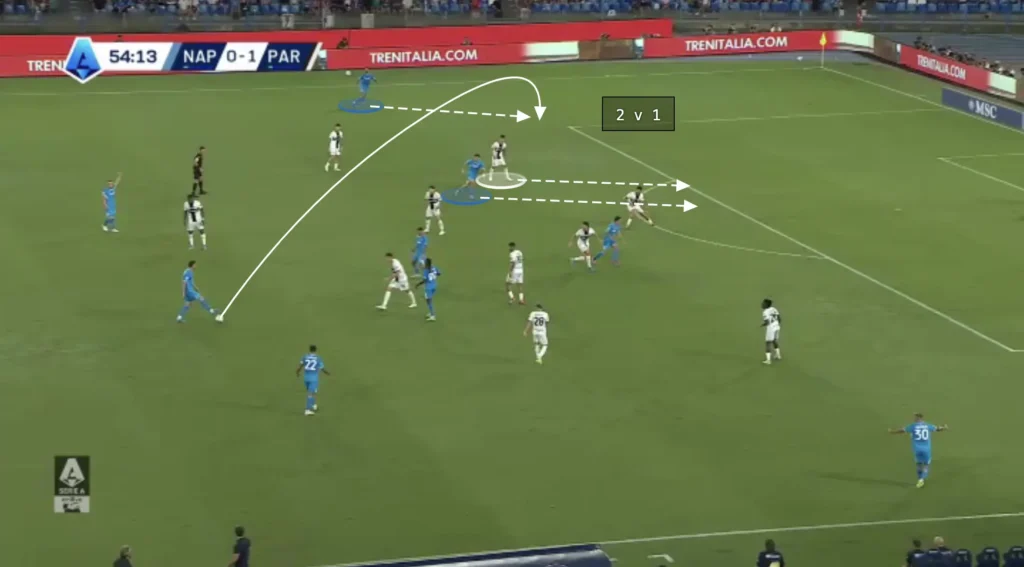
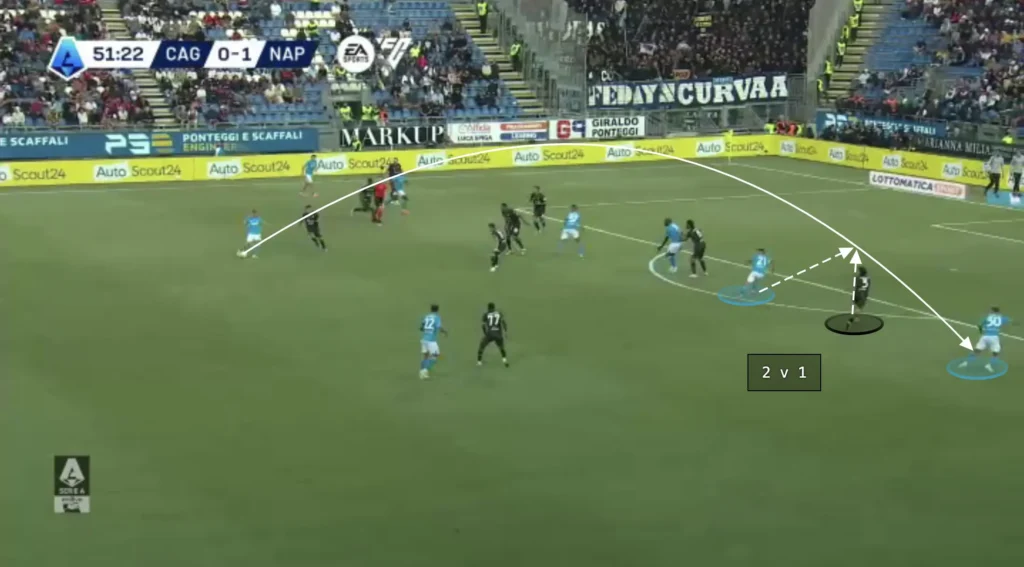
If the opposition fullback does not follow the attacking midfielder’s run, a through-ball could be played straight to the attacking midfielder, who could take the ball forward and create a 1v1 against the goalkeeper.
Attacking the Half-Space
In the 1-3-2-5 formation, Conte’s players usually look to create chances by attacking the space between the opposition center-back and fullback. They primarily do this from the wide areas with underlaps from the attacking midfielders. When the winger receives the ball out wide he will attract the opposition fullback. This opens the space between the fullback and the center-back, which allows Napoli’s attacking midfielder to make the underlapping run into this space. The ball can be played to the underlapping player, who can cross the ball into the box or attack his defender in a 1v1 situation.
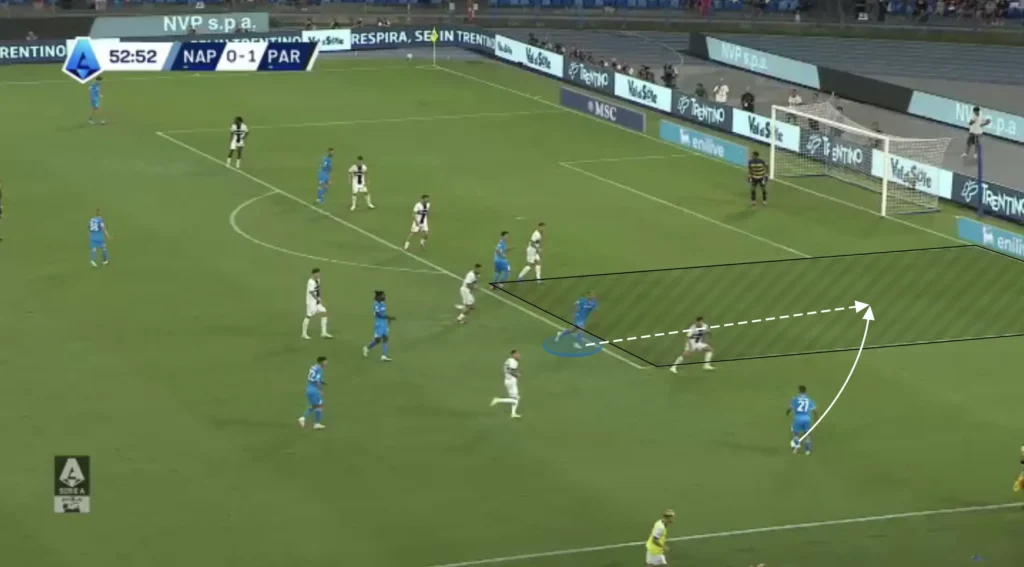

The winger does not have to play the ball to the underlapping player. The run from the attacking midfielder will often drag away an opposition defensive midfielder, which opens the space inside. The winger can take the ball inside and shoot or find a pass to a free player in front of the backline.
Transitions
Defensive Transitions
Napoli are great in defensive transitions. They always have many players high up and close to the ball, which creates good conditions for counterpressing. Many players close to the ball after losing possession means that many players can work towards regaining possession. Conte’s players are also very aggressive in the first seconds after losing the ball. The four or five players closest will immediately jump on the opposition player with the ball and close the distance to cut off any passing lanes. This approach disrupts the opponent’s transition from defense to attack, forcing errors and creating opportunities to regain control in dangerous areas.
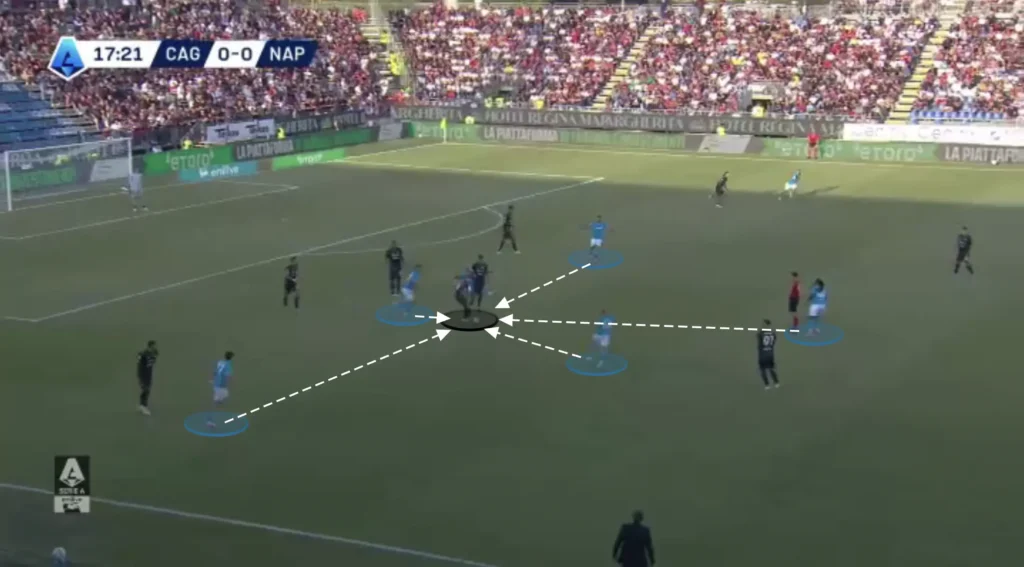
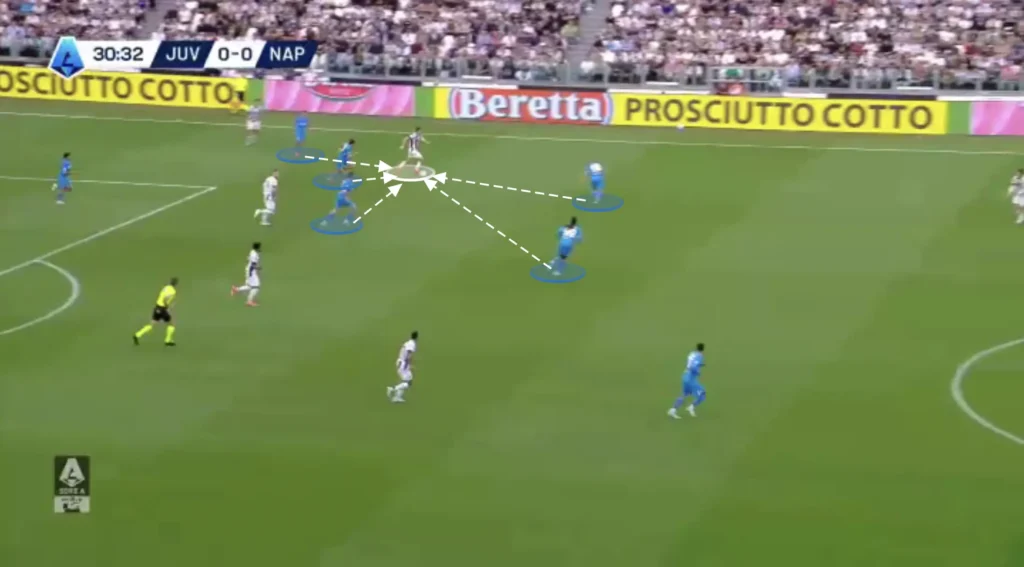
Counterpressing like this keeps Napoli on the front foot, allowing them to dominate possession and create more scoring opportunities. However, it requires exceptional fitness, tactical discipline, and teamwork.
Offensive Transitions
Antonio Conte also wants his team to counterattack in their offensive transitions. When winning the ball back, the team transitions quickly from defense to attack, utilizing the speed and movement of their forward players. Conte emphasizes vertical passes to exploit spaces left by the opposition, often targeting wide areas or gaps between defenders. Napoli’s counterattacks are well-organized, with players making intelligent off-the-ball runs to create overloads and support the ball carrier. This quick, direct style catches opponents off guard, making Napoli a dangerous team on the break.
Additionally, Napoli’s aggressiveness means they have many players high up when defending, which enables them to incorporate more players into the counterattacks. This often creates numerical advantages against the opposition defenders, making it easier to create clearcut chances.
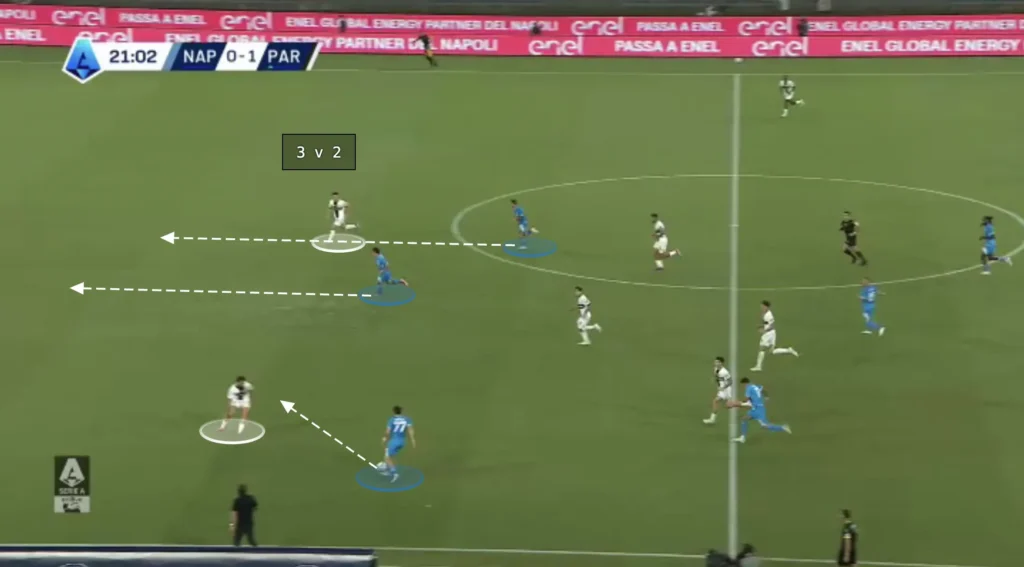
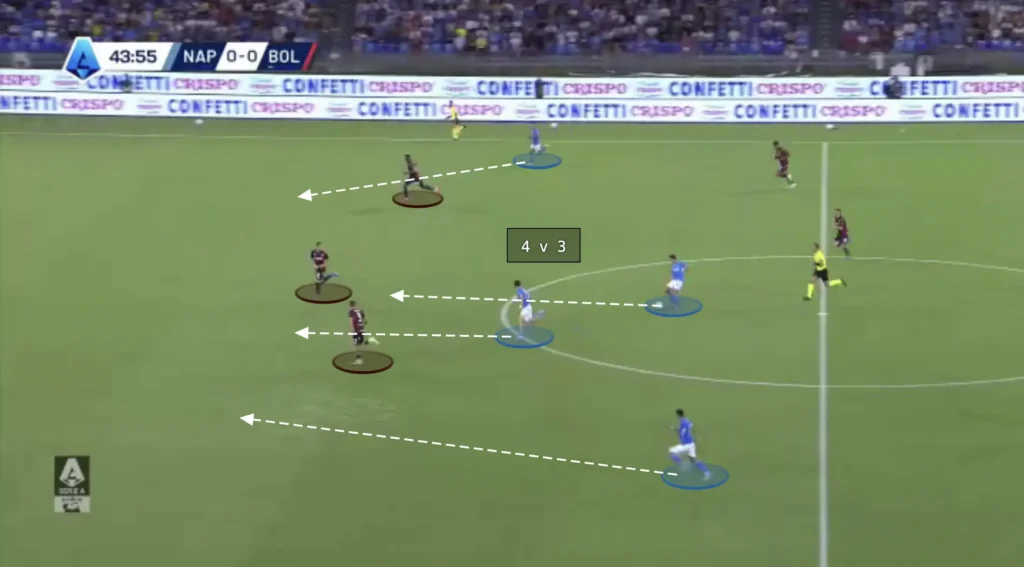
Final Thoughts
In conclusion, Antonio Conte’s tactical influence at Napoli has brought a new level of intensity and discipline to the team. His well-structured formations, defensive organization, and rapid transitions have shaped Napoli into a more balanced and cohesive unit. Conte’s emphasis on pressing, compactness, and quick counterattacks has made Napoli a formidable force in both defense and attack.
While there are areas to refine, such as breaking down low-blocks, Conte’s tactical approach is already proving successful. As the season progresses, his systems will likely continue to evolve, making Napoli a stronger contender in both domestic and European competitions.
